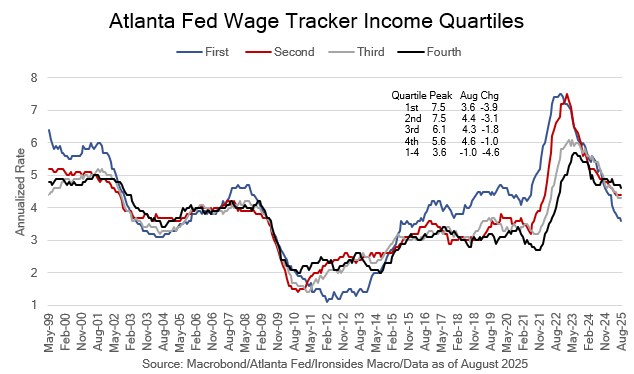The Road to Redemption
The rate plan, a silent dissent, the inflation environment is more favorable than last September, labor churn collapse, bank ROE boost, not a bubble yet, reducing cash
Note: We will be in NYC next week, consequently, next week’s note may be delayed until Sunday evening.
The Road to the Policy Rate Redemption
“Everybody has a plan until they get punched in the mouth” Mike Tyson
The FOMC’s summary of economic projections, known as the DOT plot, is a misunderstood quarterly exercise. The participants are solving for the optimal policy rate that minimizes divergences from their 2% inflation target and their estimate of the non-accelerating inflation rate of unemployment (u*). Chair Powell has repeatedly emphasized during his 7-year tenure, beginning with his first Jackson Hole ‘navigating by the stars under cloudy skies’ speech, the Fed should be humble with respect to their forecasts. With that in mind, FOMC policy rate projections in ‘26, ‘27 and the longer run are of little or no use to investors, however, with the median projection for the policy rate expecting two more 25bp cuts in ‘25 with only two meetings left in the year it is clear the Committee has a plan.
Last year the FOMC had a recalibration plan, they cut 50bp and projected another 2 25bp cuts in the final two meetings of the year. They promptly got punched in the mouth twice in the next couple of weeks. The first blow was an upward revision to gross domestic income from the annual benchmark revision to the Bureau of Economic Analysis national accounts. The second shot was a 254,000 increase in nonfarm payrolls from September employment report. Turns out that report was a mess, the unemployment rate increased, wages and the work week eased, but the BLS mysteriously guesstimated a surge in employment for the 16-24 age cohort. Against the backdrop of a persistent weakening of the labor market 10-year USTs had rallied 100bp from April through September. Following the two data blows the market turned its attention to the presidential campaign with both candidates promoting policies that market participants believed would increase the supply of Treasuries and 10s retraced the entire rally by the time the FOMC executed their 100bp rate recalibration plan. Evidence that the UST 4Q24 correction attributable to supply concerns was paltry increase of 12,000 in October payrolls and 2-month revision of -112,000 in the final days before the election.
While we branded our strategy notes ‘It’s never this different this time’, we are careful to note it is rarely the same as the last time. The starkest difference from a year ago is a factor the Fed consistently underestimates, government spending. In 3Q24 federal government spending increased at an 8.9% quarterly annualized rate, in 2Q25 it contracted 4.7%. The deceleration in government spending in ‘25 is a contributing factor to non-housing services CPI cooling from 4.8% when the FOMC began the ‘24 rate cuts to 3.2%, but inflation wasn’t much of a factor in the ‘24 Treasury market correction during the rate cuts, and it is unlikely to be the catalyst for a correction in 4Q25 either. All that said, 10s rallied to our target of 4.00% before the Fed meeting, and is undergoing a modest buy the rumor, sell the news correction we thought could occur in the equity market.
We remain secular bond bears, but cyclical bond bulls. We expect growth to accelerate in ‘26, but the mix, stronger nonresidential and residential investment, below trend consumption, and weaker government spending, is disinflationary. As ‘26 progresses, demand for capital could begin to weaken the technical dynamic that has driven credit spreads to extremely tight levels, but for now the duration risks from economic fundamentals, stable supply and the two large lingering issues, excessive Treasury bill issuance and the Fed’s longer than optimal portfolio duration, are unlikely to push longer term yields significantly higher. In other words, 4Q25 is unlikely to be like the last time the Fed had a rate cut plan. We are neutral duration at current levels, but for the reasons mentioned would be a buyer above 4.25% on 10s.
In this week’s note we review the FOMC policy rate forecast, their mandates, the primary beneficiary of rate cuts, provide our case for the AI boom continuing, and finish with our markets outlook.



